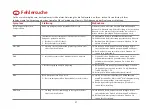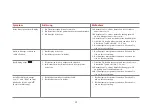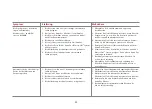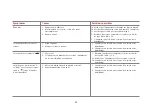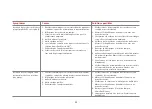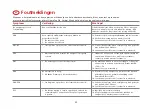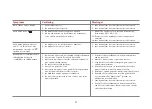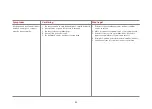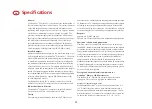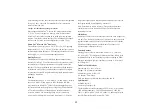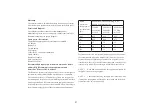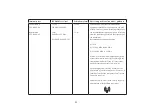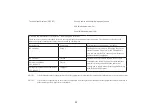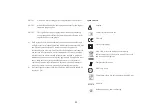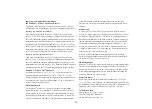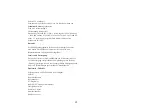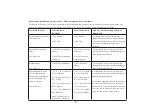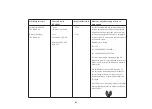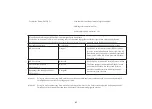
49
General
The HemoCue
®
Glucose 201
+
is a system for the determination of
the total amount of glucose in whole blood. The system consists of
a specially designed analyzer with specially designed cuvettes
containing dried reagents. The cuvette serves as a pipette, reaction
vessel and as a measuring cuvette. No dilution is required. The
glucose measurement takes place in the analyzer, which follows
the progress of the reaction and presents the result only when the
end point of the reaction has been reached. The system is fac-
tory calibrated and needs no further calibration. The HemoCue
glucose reference system is traceable to an Isotope Dilution Gas
Chromatography - Mass Spectrometry (ID GC-MS) method.
Intended purpose
Quantitative determination of glucose in whole blood using a spe-
cially designed analyzer, the HemoCue
®
Glucose 201
+
. The quan-
titative determination of the instant blood glucose concentration
in circulation supplements the clinical evidence in the diagnosis
and treatment of the diabetic patient as well as in the monitoring
of neonatal blood glucose levels. To establish HemoCue Glucose
reference values and an intervention level, neonatal blood samples
should be evaluated against a suitable laboratory method, taking
into consideration the difference between whole blood and plasma
reference values. HemoCue Glucose 201 Microcuvettes are for
In Vitro Diagnostic use only.
The HemoCue Glucose 201
+
Analyzer is only to be used with
HemoCue Glucose 201 Microcuvettes. For professional use only.
IVD Medical Device Directive
The HemoCue
®
Glucose 201
+
complies with the IVD Medical
Device Directive 98/79/EC and carries the CE mark.
Theory
The chemistry method utilised by the HemoCue
®
Glucose 201
Microcuvette is a modified glucose dehydrogenase method described
by Banauch et al.
2
A chromogen compound is added to the reagents
according to the principle outlined by Bergmeyer
3
with saponin
used for haemolysing the erythrocytes. The absorbance is measured
at two wavelengths (667 and 840 nm) to compensate for turbidity.
Reagents
Saponin, NAD, MTT and NaF.
Enzyme mix: Glucose Dehydrogenase, Diaphorase and Mutarotase.
Specimen collection and preparation
Capillary, venous or arterial blood may be used. The anticoagu-
lants EDTA, sodium heparin and lithium heparin with and without
gel and the glycolysis inhibitors sodium fluoride, sodium oxalate
and potassium oxalate shall be used. Glycolysis is a major concern
in all glucose measurements. To minimise the effect of glycolysis,
measure the blood sample as soon as possible after taking the
sample. Samples of blood collected in containers with recom-
mended anticoagulants should be analysed within 30 minutes. Mix
all samples thoroughly by inverting the sample-container at least
10 times before measurement. Note! Lithium heparin with gel can
not be used after centrifugation.
Storage and environmental requirements for
HemoCue
®
Glucose 201 Microcuvettes
Use the HemoCue
®
Glucose 201 Microcuvettes prior to their
expiry date. The expiry date is printed on each package.
Storage for cuvettes kept in a vial
Store unopened HemoCue
®
Glucose 201 Microcuvettes below 8 °C
(46 °F) (incl. storage in a freezer). Note, microcuvettes stored in a
freezer must be allowed to reach room temperature (approx. 30 min-
utes) before analysis. Cuvettes kept in an opened vial are stable for
30 days when stored in a refrigerator at 2– 8 °C (35 – 46 °F).
Specifications
GB
Summary of Contents for Glucose 201+
Page 2: ......
Page 6: ...6 Components Bestandteile Composants Onderdelen ...
Page 8: ...8 1a 3 1c 5 1b 2 4 6 Start up Einschalten Démarrage Opstarten ...
Page 14: ...14 5 6 7 8 ...
Page 16: ...16 9 10 11 ...
Page 18: ...18 15 16 13 12 15 14 ...
Page 22: ...22 4 1 2 5 6 3 Set up QC test Einstellung QC Test Configurer Test QC Set up QC test ...
Page 82: ......
Page 83: ......



